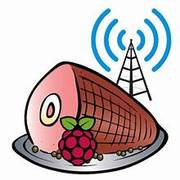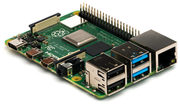Raspberry Pi/ JTDX / Gridtracker setup.
Download software for Configuring and Running Raspberry Pi 4B 8GB
To get started you are going to need a few items.
1) A Raspberry Pi 4b 8gb single board computer,
2) A 5V 3A Power Supply with USB C Connection
3) 1 or 2 Micro HDMI to HDMI converter cables (depends if you want one or 2 monitors),
4) 1 or 2 HDMI Regular HDMI Cables (Depending on the number of monitors)
5)Case for the RPi 4b (This one includes a cooling fan,
6) 2 each 128gb Micro SD Cards (1 to use and 1 for a spare).
7 )Display. I use an old small TV with an HDMI port.You can also find displays on amazon made for RPi.
8) It's a good idea to use usb extension cables, not necessary but I recommend using them.
9) And to operate on weak signal modes such as FT8 you will need a way to keep the time accurate such as using a GPS module, Click this link. Almost forgot, you will need a keyboard and mouse. I use this small usb/bluetooth keyboard with a built in touchpad.
Next you will need to download some programs on your PC to prepare the micro SD card before inserting it in the RPi. First, download and install SD Card Fortmatter use to format the micro SD card. Next, download and install Balena Etcher program. This is what you will use to "burn" the raspberry pi operating system image to SD Card. Lastly, download the HamPi Software package created by W3DJS, located here. This is for Version 2.0. There is a version 3.3 but I just couldn't get it to work.
Before starting to burn the image, if your PC does not have a slot or an adapter for an SD Micro card you may need to order this usb adapter.
Prepare your SDMicro card and burn the image...
First, Inset the card into the SD Card adapter and place in the computer. Open SD Card Formatter and format the card. Initially, I recommend a full format over a quick format.
Next, Leave the adapter and card in the computer and run Belena Etcher program. From here you will select the location of the file for the HamPi 2.0 image and select the image; Now, select the location of the SD Card; Press image. This can take a little while because it will burn the image to the card and verify the image is on the card.
Your card is ready for the Raspberry Pi....
Prepare the RPi and insert the SD Card..
Now, it's time to prepare the Raspberry Pi... Follow the directions with the case and RPi to ensure the heat sinks are properly placed and the fan is wired correctly. Once, the RPi is securely in the case, place the SD Card into the slot on the RPi per the directions. Put the usb dongle in the usb2.0 slot for the keyboard or plug the keyboard in if you chose to use a wired keyboard. Next, plug the HDMI Cable into the HDMI to HDMI micro converter cable then into the microHDMI port closest to the USB-C power connection. Plug the other end of the HDMI cable to the monitor/TV. Now, time for power!!! plug the USB-C power supply connection into the RPi then the AC Connection into the wall and turn on the power. Follow the on screen prompts for setup. Default login/password is pi/raspberry.
Time to get the GPS running....
Install a usb extention cable in the RPi usbslot and plug the USB Dongle into the cable with the power to the RPi OFF. Turn on the RPi. open a terminal window by clicking on the terminal window icon at the top of the screen. Then Proceed with the following:
Just a quick video where TheSmokinApe shows how to install and configure a Ublox GPS on a Raspberry Pi 4. from TheSmokinApe Youtube Channel https://youtu.be/isVHkovZuSM?si=EZ-RyujqT8rxm513
#Install Updates: sudo apt-get update sudo apt-get upgrade
#see USB devices: lsusb
#Install GPS software: sudo apt -y install gpsd gpsd-clients python-gps
#Edit GPS config file: sudo nano /etc/default/gpsd
#Add this to file: START_DAEMON=”true” USBAUTO=”true” DEVICES=”/dev/ttyACM0″ GPSD_OPTIONS=”-n”
#Install chrony: sudo apt-get install chrony
#reboot pi
#check to see if services are running: systemctl is-active AND gpsd systemctl is-active chronyd
#Check GPS output: cgps – s OR gpsmon -n
#Edit chrony config file: sudo nano /etc/chrony/chrony.conf
#Add this to end of file: refclock SHM 0 offset 0.5 delay 0.2 refid NMEA
#Check Chrony Output: sudo chronyc sources -v Check chrony output sudo chronyc tracking
#Force time sync: sudo chronyc makestep
This all worked great for me!!!
Turn your Raspberry Pi 4 into a hotspot for doing digital in the field..
So you want to do FT8 in the field with your Raspberry Pi and VNC into it with your tablet, phone or laptop? Normally, this is impossible unless you have a hotspot or network to connect to... until now.. Now you can!!! KM4ACK has written a script to install that turns your Raspberry Pi into a hotspot, it'sown virtual network. Then you can use the Raspberry Pi as a VNC Server and use the VNC Viewer on another device to login to the Raspberry Pi. Here is his link: KM4ACK Auto Hotspot Instructional Video. With this Auto Hotspot Script installed if your wifi drops in your shack the RPiHotspot is automatically enabled. It works GREAT!!! It is step by step.. If a dummy like me can do it, so can you. Here is the link to the code referenced in the video: https://github.com/km4ack/pi-scripts/blob/master/autohotspotN-setup
Click Here To Use With FT991...In the works
Click Here to See My JTDX Settings for use with FT891 and RPi.
Click Here to See My Gridtracker Settings (Coming Soon)

